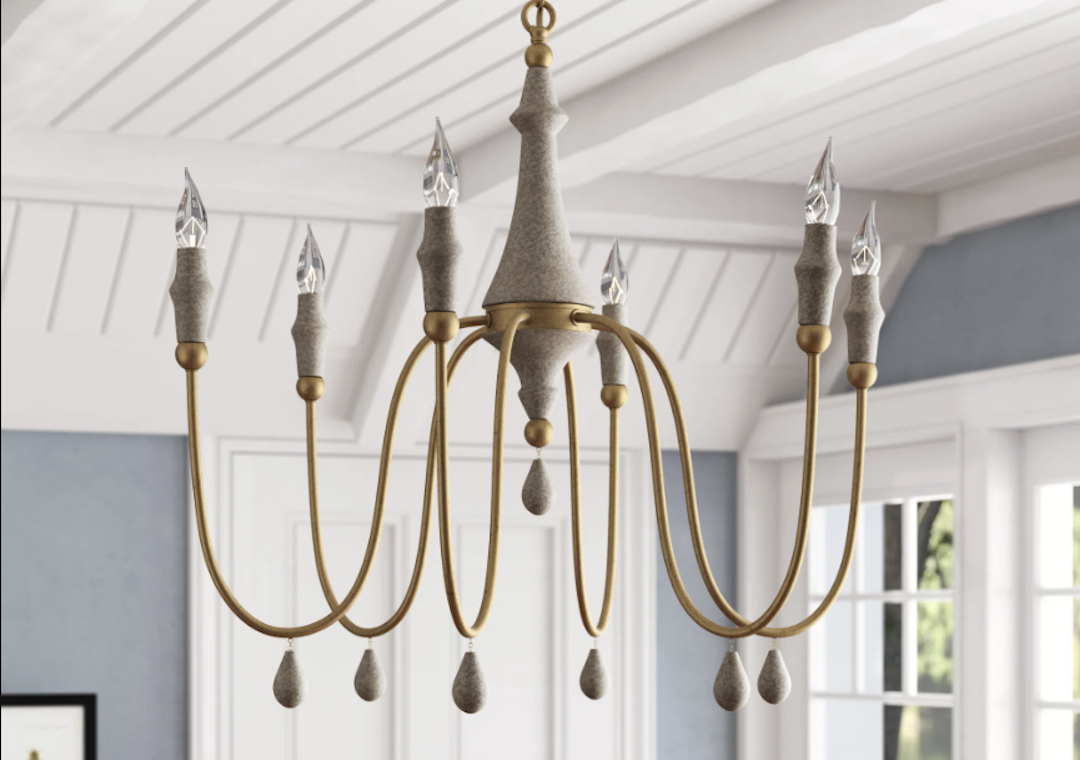
Embracing Wabi-Sabi: Clay Chandelier Elegance
Wabi-sabi is a Japanese aesthetic philosophy that celebrates the beauty found in imperfection, transience, and the natural cycle of growth and decay. Rooted in Zen Buddhism, this concept encourages an appreciation for the fleeting nature of life and the unique characteristics that arise from it. The term “wabi” refers to a rustic simplicity, a sense of understated elegance that often embraces the natural world, while “sabi” denotes the beauty that comes with age and wear.
Together, these elements create a holistic view that values authenticity over perfection, inviting individuals to find beauty in the mundane and the imperfect. In practical terms, wabi-sabi can manifest in various forms, from art and architecture to everyday objects. It encourages a mindful approach to living, where one learns to appreciate the subtle nuances of life rather than striving for unattainable ideals.
This philosophy resonates deeply in contemporary design, where there is a growing movement towards sustainability and a return to handcrafted items. By embracing wabi-sabi, individuals can cultivate a deeper connection with their surroundings, fostering an environment that reflects their values and experiences.
The Beauty of Imperfection in Clay Chandeliers
Clay chandeliers Unilamplighting epitomize the wabi-sabi philosophy through their inherent imperfections and organic forms. Each piece is unique, shaped by the hands of artisans who pour their creativity and emotion into the crafting process. The irregularities in texture, color variations, and asymmetrical designs contribute to the charm of these light fixtures, making them not just sources of illumination but also works of art that tell a story.
For instance, a clay chandelier may feature uneven edges or a glaze that has developed subtle cracks over time, each imperfection adding character and depth to the piece. The beauty of imperfection in clay chandeliers lies in their ability to evoke a sense of nostalgia and warmth. Unlike mass-produced lighting fixtures that often prioritize uniformity and sleekness, handcrafted clay chandeliers invite viewers to appreciate the artistry involved in their creation.
This connection to the maker imbues each piece with a sense of history and authenticity, allowing it to resonate on a personal level with those who choose to incorporate it into their homes. The interplay of light and shadow created by these unique forms further enhances their allure, casting enchanting patterns that transform any space into a sanctuary of tranquility.
Embracing Simplicity and Natural Materials
Simplicity is a cornerstone of wabi-sabi design, emphasizing the importance of minimalism and functionality. In the context of clay chandeliers, this principle manifests through clean lines and unadorned forms that allow the material itself to shine. The use of natural materials such as clay not only aligns with the wabi-sabi ethos but also fosters a deeper connection to nature.
Clay, as an earth-derived substance, carries with it the essence of the environment from which it originates, grounding the design in authenticity. Natural materials also contribute to the overall aesthetic experience by introducing organic textures and colors into a space. The earthy tones of clay can range from soft beiges to rich terracottas, each hue reflecting the natural world and creating a harmonious atmosphere.
When combined with other elements like wood or stone, clay chandeliers can enhance the overall design narrative of a room, promoting a sense of balance and serenity. This emphasis on simplicity encourages individuals to curate their spaces thoughtfully, selecting pieces that resonate with their personal style while honoring the principles of wabi-sabi.
Clay Chandeliers: A Timeless Elegance
Clay chandeliers possess a timeless elegance that transcends fleeting design trends. Their ability to blend seamlessly into various interior styles—from rustic farmhouse to modern minimalist—makes them versatile choices for any home. The organic shapes and earthy tones of these fixtures create an inviting ambiance that can elevate both casual and formal settings.
For example, a large clay chandelier with flowing curves can serve as a stunning focal point in a dining room, drawing attention while maintaining an air of understated sophistication. Moreover, the longevity of clay as a material ensures that these chandeliers can withstand the test of time. Unlike synthetic materials that may degrade or go out of style, clay chandeliers age gracefully, developing a patina that enhances their character.
This quality aligns perfectly with the wabi-sabi philosophy, which values the beauty found in aging and wear. As these fixtures become part of a home’s narrative over time, they foster a sense of continuity and connection, reminding inhabitants of cherished moments shared beneath their glow.
Incorporating Wabi-Sabi into Interior Design
Incorporating wabi-sabi into interior design involves more than just selecting specific items; it requires a mindset shift towards valuing authenticity and simplicity. One effective way to embrace this philosophy is by curating spaces that reflect personal stories and experiences. This can be achieved by incorporating handmade items, such as clay chandeliers, alongside vintage finds or family heirlooms that carry sentimental value.
Each piece contributes to a narrative that celebrates individuality rather than conforming to mainstream trends. Additionally, creating spaces that prioritize comfort and tranquility is essential in wabi-sabi design. This can be accomplished through thoughtful arrangements that encourage relaxation and mindfulness.
For instance, pairing a clay chandelier with soft textiles, natural light sources, and greenery can create an inviting atmosphere conducive to reflection and peace. The goal is to foster environments where imperfections are embraced, allowing inhabitants to feel at ease in their surroundings while appreciating the beauty inherent in life’s transitory moments.
The Art of Handcrafted Clay Chandeliers
The creation of handcrafted clay chandeliers is an art form that embodies the principles of wabi-sabi through its emphasis on craftsmanship and individuality. Artisans who specialize in this craft often draw inspiration from nature, allowing organic shapes and textures to inform their designs. The process typically involves shaping raw clay by hand or using traditional techniques such as coiling or slab building.
This tactile engagement with the material fosters a deep connection between the maker and the creation, resulting in pieces that are imbued with intention and emotion. Moreover, the glazing process further enhances the uniqueness of each chandelier. Artisans may experiment with various glazes that react differently during firing, leading to unexpected color variations and surface textures.
This unpredictability is celebrated within the wabi-sabi framework, as it highlights the beauty found in chance occurrences rather than striving for uniformity. Each handcrafted clay chandelier becomes a testament to the skill and creativity of its maker while serving as a reminder of the transient nature of beauty itself.
Finding Peace and Harmony in Wabi-Sabi Design
Wabi-sabi design encourages individuals to seek peace and harmony within their living spaces by fostering an environment that reflects their values and experiences. This approach promotes mindfulness by inviting inhabitants to slow down and appreciate the present moment rather than becoming preoccupied with perfection or material accumulation. By surrounding oneself with objects that resonate on a personal level—such as handcrafted clay chandeliers—individuals can cultivate a sense of belonging and tranquility within their homes.
Creating harmony through wabi-sabi design also involves considering how different elements interact within a space. The careful selection of colors, textures, and materials can evoke feelings of calmness and balance. For instance, pairing earthy tones found in clay chandeliers with soft fabrics or natural wood finishes can create an inviting atmosphere that encourages relaxation.
This intentionality fosters an environment where individuals can unwind and reconnect with themselves amidst life’s chaos.
Embracing Wabi-Sabi: Bringing Tranquility into Your Home
Embracing wabi-sabi within one’s home is ultimately about cultivating tranquility through authenticity and simplicity. By incorporating elements such as handcrafted clay chandeliers into interior spaces, individuals can create environments that reflect their unique stories while celebrating the beauty found in imperfection. This journey towards embracing wabi-sabi encourages individuals to let go of rigid standards and expectations, allowing them to appreciate life’s fleeting moments more fully.
In practical terms, this might involve decluttering spaces to make room for meaningful items that resonate personally or investing in handcrafted pieces that embody the spirit of wabi-sabi. By prioritizing quality over quantity and seeking out items that evoke emotion rather than mere aesthetics, individuals can transform their homes into sanctuaries of peace and harmony. Ultimately, embracing wabi-sabi invites individuals to find joy in simplicity while fostering deeper connections with themselves and their surroundings—a journey well worth undertaking for anyone seeking tranquility in today’s fast-paced world.

